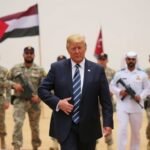Zelensky‘s Urgent Call: Expand US Sanctions on Russian Oil and Supply Long-Range Missiles to Counter Invasion
In a impassioned address that underscores the dire stakes of Ukraine’s ongoing struggle, President Volodymyr Zelensky has urgently appealed to the United States to intensify economic pressure on Russia by imposing sweeping sanctions on all Russian oil companies. Speaking virtually to a gathering of international leaders, Zelensky also renewed his request for the delivery of long-range missiles, arguing they are essential for Ukraine to mount an effective defense against relentless Russian assaults. This plea comes at a critical juncture, as Russian forces continue to advance in eastern Ukraine, testing the resolve of Western allies.
- Zelensky’s Stark Warning on Russian Oil Funding the War
- Strategic Imperative: Long-Range Missiles to Strike Deep into Enemy Lines
- US Policy Crossroads: Balancing Support with Escalation Risks
- Russia’s Response and Global Ripples from Tighter Sanctions
- Path Forward: Implications for Ukraine’s Survival and Western Unity
Zelensky’s words, delivered with the weight of a nation under siege, highlight the interconnected battles on the economic and military fronts. “The US must act decisively now,” he stated, emphasizing that partial measures have allowed Russia to fund its war machine through oil revenues. As the conflict enters its third year, these requests could reshape the trajectory of support for Kyiv, potentially altering the balance of power in Europe’s largest land war since World War II.
Zelensky’s Stark Warning on Russian Oil Funding the War
President Zelensky’s appeal begins with a sobering assessment of Russia’s economic lifeline: its vast oil industry. Despite initial waves of sanctions following the full-scale invasion in February 2022, major Russian oil producers like Rosneft and Gazprom Neft have continued to export crude, raking in billions that directly fuel military operations. According to data from the International Energy Agency (IEA), Russia exported approximately 7.5 million barrels per day in 2023, generating over $300 billion in revenue—enough to sustain a war economy even under pressure.
“Every barrel of Russian oil sold is a bullet fired at Ukrainian civilians,” Zelensky declared in his address. He urged the US to close loopholes that allow Russian oil to flow to markets in India and China via shadow fleets of tankers. This call aligns with recent reports from the US Treasury Department, which identified over 600 such vessels evading sanctions. By targeting all Russian oil entities, Zelensky argues, the West could slash Moscow’s war chest by up to 40%, based on estimates from the Kyiv School of Economics.
The Ukrainian leader’s push gains urgency amid reports of intensified Russian strikes on energy infrastructure. In the past month alone, Russian missiles have damaged 50% of Ukraine’s power generation capacity, leaving millions without heat as winter approaches. Zelensky’s plea to the US isn’t just rhetorical; it’s a strategic bid to weaken Russia’s ability to sustain such campaigns.
Strategic Imperative: Long-Range Missiles to Strike Deep into Enemy Lines
Beyond economics, Zelensky’s request for long-range missiles represents a pivotal escalation in military aid. Ukraine currently relies on shorter-range systems like the US-supplied HIMARS, which have proven effective in targeting logistics hubs but fall short against rear-area command centers deep inside Russia. Zelensky specifically called for ATACMS (Army Tactical Missile System) with a range exceeding 300 kilometers, allowing strikes on ammunition depots and airfields that support frontline advances.
“Without these missiles, our soldiers are fighting with one hand tied behind their backs,” Zelensky told reporters post-address. This isn’t a new ask; in September 2023, the Biden administration approved a limited batch of ATACMS, but restrictions on their use—prohibiting strikes inside Russia—have hamstrung their impact. Recent battlefield developments, including Russia’s capture of Avdiivka in February 2024, have amplified the need. Ukrainian forces report that Russian buildups near Kharkiv and Donetsk could be disrupted with deeper strikes, potentially saving thousands of lives.
Military analysts, such as those from the Institute for the Study of War, note that long-range capabilities could shift the war’s momentum. For instance, a single ATACMS salvo could neutralize a Russian S-400 air defense battery, opening skies for Ukrainian drones. Yet, US hesitation stems from fears of nuclear escalation, with President Biden citing risks of “World War III” in private discussions. Zelensky countered this by pointing to Russia’s own use of long-range Iskander missiles against Ukrainian cities, framing the request as parity rather than provocation.
US Policy Crossroads: Balancing Support with Escalation Risks
The United States, as Ukraine’s largest donor with over $75 billion in aid since 2022, now faces a defining moment. Zelensky’s dual requests test the Biden administration’s strategy of providing robust support without direct confrontation with Russia. On the sanctions front, the US has already banned imports of Russian oil and imposed secondary sanctions on entities dealing with Moscow’s energy sector. However, expanding to all companies would require congressional approval and could face pushback from global allies reliant on discounted Russian crude.
Key figures in Washington are weighing in. Senate Foreign Relations Committee Chair Ben Cardin praised Zelensky’s “moral clarity,” stating, “Sanctions must evolve to match Russia’s aggression.” Meanwhile, House Speaker Mike Johnson, a vocal Ukraine supporter, has advocated for missile deliveries in recent briefings. Economically, the US Energy Information Administration (EIA) projects that broader sanctions could raise global oil prices by 5-10%, adding pressure on American consumers amid inflation concerns.
Yet, domestic politics complicate the picture. With the 2024 presidential election looming, Republican critics like Senator Rand Paul argue that unlimited aid drains US resources. Zelensky’s appeal arrives just as a $61 billion aid package stalls in Congress, underscoring the political tightrope. If approved, these measures could bolster Ukraine’s position ahead of potential peace talks, but delays risk further territorial losses.
Russia’s Response and Global Ripples from Tighter Sanctions
Moscow has swiftly rebuked Zelensky’s overtures, with Kremlin spokesman Dmitry Peskov labeling them “desperate provocations.” Russian Foreign Minister Sergey Lavrov warned that long-range missiles would cross a “red line,” echoing threats of retaliation. In a broader context, Russia’s economy has shown resilience, with GDP growth of 3.6% in 2023 per IMF data, largely buoyed by oil exports and wartime spending. However, cracks are emerging: inflation at 7.5% and a ruble devaluation highlight vulnerabilities that comprehensive US sanctions could exploit.
Globally, the implications are profound. Europe, which has reduced Russian gas imports by 80% since 2022, still imports refined products indirectly linked to Russian crude. Countries like India, purchasing 1.5 million barrels daily from Russia, might face US penalties, potentially disrupting supply chains. Environmental groups, including Greenpeace, support the sanctions, arguing they accelerate the shift from fossil fuels. Meanwhile, Ukraine’s energy woes—exacerbated by Russian attacks—have led to blackouts affecting 20% of the population, per UN reports.
Zelensky’s strategy also involves multilateral pressure. He referenced upcoming G7 meetings, where leaders could coordinate with the EU on unified sanctions. This approach aims to isolate Russia further, building on the price cap of $60 per barrel that has already curbed revenues by $100 billion since its inception.
Path Forward: Implications for Ukraine’s Survival and Western Unity
Looking ahead, Zelensky’s requests could catalyze a renewed commitment from the US and its allies, potentially tipping the scales in Ukraine’s favor. If long-range missiles are greenlit without restrictions, Ukrainian commanders anticipate disrupting Russian supply lines within months, buying time for mobilized forces to regroup. On the sanctions side, full implementation might force Russia to the negotiating table, especially as its military faces manpower shortages with over 500,000 casualties reported by Western intelligence.
Yet, the road is fraught. Diplomatic efforts, including backchannel talks via Turkey, suggest Putin seeks concessions on territory. Zelensky remains firm: “No peace without justice.” For the US, approving these measures would signal unwavering support, possibly deterring aggression elsewhere, from Taiwan to the Middle East. As winter bites and Russian offensives loom, the coming weeks will test alliances forged in the fires of invasion.
In the broader narrative of resilience, Ukrainians draw hope from Zelensky’s unyielding voice. Stories from the frontlines—soldiers holding Bakhmut’s ruins, civilians rebuilding in Kherson—illustrate the human cost driving this appeal. The world’s response will not only shape Ukraine’s fate but redefine the post-Cold War order, proving whether economic and military solidarity can prevail over autocratic ambition.








